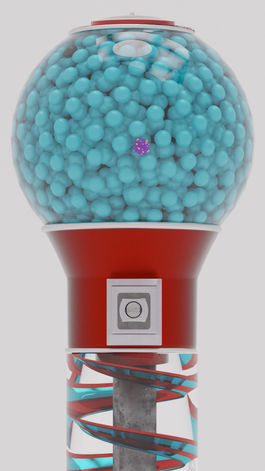Will Cammell
Videographer
Video Editor
3D Artist
I had just finished my chair and felt pretty capable of doing something else, this time without any reference or tutorial. I wanted to do what I had done for Henry's music video. I liked working based on someone else's request. This way, I couldn't give up if it got too hard. Signing a social contract with someone seemed to me like the best way to really develop. The next day, I asked my neighbor, Bryce, what I should model next. He responded by saying, 'I don't know why, bro, but a gumball machine would be sick.' Anything for you, Bryce.
I got to work by starting the same way the chair tutorial had started me off, by adding reference photos that I downloaded off of Google Images. After that, I started modeling the basic geometry of the gumball machine. It only took me about an hour and a half to have something that looked like an empty gumball machine with no balls, turn knob, ball dispenser, or a spiral running down it. These were all things I was putting off because I needed to think about how I could tackle them. The turn knob and ball dispenser ended up being easy solutions to figure out. I separately did both while in edit mode with the base of the gumball machine selected and then later dragged both into place, right-clicked, and hit convert to mesh, and then parented the objects to the base of the machine.
I don't believe I'm exaggerating when I say that the spiral carrying the balls down and the balls filling the container would end up being two of the hardest things I've ever managed to do in Blender. Obscure shapes like these require a venture into the eternal torment that is geometry nodes. Remember, in this case, we are dealing with geometry nodes. Nodes represent individual operations or functions and are connected in a visual network to create effects or workflows. Each node performs a specific task, and the connections between them define the flow of data, allowing users to create intricate and flexible setups without diving into complex code or interfaces. It's a visual and modular way to design and control various aspects of 3D scenes in Blender.
Essentially, it's Blender’s own language of code. After hours of fiddling with the nodes, I realized just how futile of an effort it really was. In times of desperation, it’s always nice to have someone or something to turn to. For me, my saving grace was, yet again, YouTube.
For the spiral, I watched a tutorial created by George Makes titled 'Modeling a Gumball Machine in Blender' and skipped to 3:00 minutes and watched until 16:45 when he had completed the node system for both the balls and the spiral. Through this process, I realized that all forms of nodding in Blender are something I need to spend more time with to feel comfortable with, the same way I now feel with modeling.
When both node systems had been completed, I began changing variables within the system to see how it would affect it, and it began to make sense to me structurally, so I opted to turn all the balls blue to make a special two balls stand out. One, a Jimmy Neutron candy, was requested by my friend Julia, and one black gumball had been requested by my friend Brenna. With almost all of the balls being blue and the outside of the machine having a red car paint texture applied to it, I went into the node system for the spiral and changed certain variables until the spiral had a red and blue swirl running down it to complement the color scheme. I later found out that this tutorial was made in Blender 3.0 while I was working in version 4.0. This explained why I wasn't able to get all the balls to change to different colors regardless of completing the tutorial step by step. It isn't quite perfect, but it functions."

The Gumball Machine







